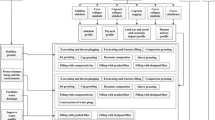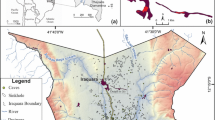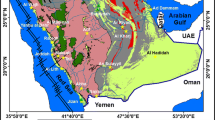Abstract
In the valley of the Ebro River to the southeast of the city of Zaragoza (NE Spain), the dissolution of evaporite sediments (gypsum, halite and Na-sulphates) which underlie alluvial deposits gives rise to numerous sinkholes. These sinkholes are a potential hazard to human safety, particularly where they develop in a catastrophic way. Even slow-developing sinkholes are problematic, as they damage urban and agricultural infrastructure, necessitating costly repairs and vigilant maintenance. To assist in developing avoidance strategies for these hazards, the factors controlling sinkhole occurrence have been assessed using geomorphological maps produced from aerial photographs for 1956 and 1981. Important controls on sinkhole development are found to include underlying geological structure (manifest in preferred orientations of sinkholes on the azimuths N130-150E and N30-40E), and the presence of glauberite in the groundwater flow path, which apparently promotes accelerated gypsum dissolution. Perhaps surprisingly, alluvium thickness does not appear to significantly correlate with the density of sinkholes on the floodplain in this area. The maps for 1956 and 1981 reveal that both human activity and natural processes can serve to obscure the true density of sinkhole development. For instance, a large number of sinkholes which were conspicuous in 1956 have since been back-filled by farmers. In the most fluvially active zone of the Ebro valley (the meander belt), the relatively low density of sinkholes compared with adjoining zones suggests that subsidence is being masked by morpho-sedimentary dynamic processes (aggradation and erosion). Careful geomorphological mapping for different time periods yields a much more accurate impression of the frequency of sinkhole development than would be gained from surveying currently visible sinkholes in the area of interest.












Similar content being viewed by others
References
Arauzo T, Gutiérrez F (1994) Evolución de los valles de fondo plano del centro de la Depresión del Ebro. In: Geomorfología en España. III Reunión de Geomorfología. Logroño, I, pp 277–290
Arlegui L (1996) Diaclasas, fallas y campos de esfuerzo en el sector central de la Cuenca del Ebro. PhD Thesis, University of Zaragoza, 308 pp
Arlegui L, Simón JL (2000) Geometry and distribution of regional joint sets in a non-homogeneous stress field: case study in the Ebro basin (Spain). J Struct Geol 23:297–313
Arlegui L, Soriano MA (1998) Characterizing lineaments from satellite images and field studies in the central Ebro basin (NE Spain). Int J Remote Sensing 19(16):3169–3185
Ball JW, Nordstrom DK (1991) User’s manual for WATEQ4F, with revised thermodynamic database and test cases for calculating the speciation of major, trace and redox elements in natural waters. U.S. Geological Survey Open-File Report 91–183, 189 pp
Beck BF (1986) A generalized genetic framework for the development of sinkholes and karst in Florida. USA Environ Geol Water Sci 8(1/2):5–18
Beck BF (1988) Environmental and engineering effects of sinkholes—the processes behind the problems. Environ Geol Water Sci 12:71–78
Beck BF (1991) On calculating the risk of sinkhole collapse. In: Kastning EH, Kastning KM (eds) Appalachian karst proceedings of the Appalachian karst symposium. National Speleological Society, Radford, pp 231–236
Benito G (1989) Geomorfología de la Cuenca Baja del Río Gállego. PhD Thesis, Univeristy of Zaragoza, 764 pp
Benito G, Gutiérrez M (1988) Karst in gypsum and its environmental impact on the middle Ebro Basin, Spain. Environ Geol Water Sci 12(2):107–111
Benito G, Pérez del Campo P, Gutiérrez-Elorza M, Sancho C (1995) Natural and human-induced sinkholes in gypsum terrain and associated environmental problems in NE Spain. Environ Geo 25:56–164
Benito G, Gutiérrez F, Pérez-González A, Machado MJ (2000) Morpho-sedimentological features in Quaternary fluvial systems affected by solution-induced subsidence in the Ebro Basin, NE Spain. Geomorphology 33:209–224
Cooper AH (1989) Airborne multispectral scanning of subsidence caused by Permian gypsum dissolution at Ripon, North Yorkshire. Q J Eng Geol 22:219–229
Cooper AH, Calow RC (1998) Avoiding gypsum geohazards: guidance for planning and construction. British Geological Survey Technical Report WC/98/5, 57 pp
Durán JJ, Del Val J, López-Martínez J (1989) El karst en las depresiones del Tajo y del Duero. In: El Karst en España. Monograph 4. Sociedad Española de Geomorfología, pp 211–216
Fernández-Nieto C, Galán E (1979) Mineralogía de los depósitos de sales de Remolinos (Zaragoza). Soc Esp Miner Extra 1:51–65
Ford D, Williams P (1989) Karst geomorphology and hydrology. Unwin Hyman, London, 601 pp
García-Veigas J, Ortí F, Fernández-Nieto C (1994) Modelo hidroquímico de sedimentación de glauberita-halita: sondeo PURASAL, Formación Yesos de Zaragoza (Mioceno inferior, Cuenca del Ebro). Geogaceta 16:136–139
Gutiérrez F (1996) Gypsum karstification induced subsidence: effects on alluvial systems and derived geohazards (Calatayud Graben, Iberian Range, Spain). Geomorphology 16:277–293
Gutiérrez F (1998) Fenómenos de subsidencia por disolución de formaciones evaporíticas en las fosas neógenas de Teruel y Calatayud (Cordillera Ibérica). PhD Thesis, University of Zaragoza, 569 pp
Gutiérrez F, Arauzo T (1997) Subsidencia kárstica sinsedimentaria en un sistema aluvial efímero: El Barranco de Torrecilla (Depresión del Ebro, Zaragoza). Cuadernos de Geología Ibérica 22:349–372
Gutiérrez F, Cooper AH (2002) Evaporite dissolution subsidence in the historical city of Calatayud, Spain: damage appraisal and prevention. Nat Hazards 25:259–288
Gutiérrez M, Gutiérrez F (1998) Geomorphology of the Tertiary gypsum formations in the Ebro Depression (Spain). Geoderma 87:1–29
Gutiérrez F, Arauzo T, Desir G (1994) Deslizamientos en el escarpe en yesos de Alfajarín (Zaragoza). Cuaternario y Geomorfología 8(1–2):57–68
Gutiérrez F, García-Hermoso F, Cooper AH (2000) Spatial assessment, mitigation and prevention of evaporite dissolution subsidence damage in the historical city of Calatayud, Spain. In: Land Subsidence. Proceedings of the 6th International Symposium on Land Subsidence, I:237–248
Gutiérrez F, Ortí F, Gutiérrez M, Pérez-González A, Benito G, Gracia J, Durán JJ (2001) The stratigraphical record and activity of evaporite dissolution subsidence in Spain. Carbonates Evaporites 16(1):46–70
Gutiérrez F, Gutiérrez M, Marín C, Maldonado C (2005) Spatial distribution, morphometry and activity of La Puebla de Alfindén sinkhole field in the Ebro Valley (NE Spain). Applied aspects for hazard zonation. Environ Geol (this issue)
Klimchouck A, Andrejchuk V (2005) Collapse and breakdown mechanisms from observations in the gypsum caves of the Western Ukraine: implications for the subsidence hazard assessment. Environ Geol (this issue)
LaMoreaux PE, Newton JG (1986) Catastrophic subsidence: an environmental hazard, Shelby County, Alabama. Environ Geol Water Sci 8(1/2):25–40
Llamas MR (1962) Estudio geológico-técnico de los terrenos yesíferos de la Cuenca del Ebro y de los problemas que plantean en los canales. Ministerio de Obras Públicas, Boletín no 12,192 pp
Macau F, Riba O (1962) Situación, características y extensión de los terrenos yesíferos en España. I Coloquio Internacional sobre las Obras Públicas en los terrenos yesíferos. Madrid 5:157–184
Martínez JD, Johnson KS, Neal JT (1998) Sinkholes in evaporite rocks. Am Sci 86:38–51
Ortí F (2000) Unidades glauberíticas del Terciario Ibérico: nuevas aportaciones. Rev Soc Geol España 13(2):227–249
Ortí F, Salvany JM (1997) Continental evaporitic sedimentation in the Ebro Basin during the Miocene. In: Sedimentary deposition in Rift and Foreland Basins in France and Spain. Columbia University Press, New York, pp 420–429
Paukstys B, Cooper AH, Arustiene J (1999) Planning for gypsum geohazard in Lithuania and England. Eng Geol 52:93–103
Ponsjack E (1940) Deposition of calcium sulfate from sea water. Am J Sci 238:559–568
Quirantes J (1978) Estudio sedimentológico y estratigráfico del Terciario continental de Los Monegros. Institución Fernando El Católico, Zaragoza, 207 pp
Regato P (1988) Contribución al estudio de la flora y la vegetación del “Galacho de La Alfranca” en relación con la evolución del sistema fluvial. Naturaleza en Aragón. DGA. Zaragoza, 189 pp
Sástago C (1796) Descripción de los canales Imperial de Aragón y Real de Tauste. Ministerio de Fomento, Madrid, 297 pp
Soriano MA (1990) Geomorfología del sector centro-meridional de la Depresión del Ebro. Institución Fernando El Católico, Zaragoza, 268 pp
Soriano MA, Simón JL (1995) Alluvial dolines in the central Ebro Basin, Spain: spatial and environmental hazard analysis. Geomorphology 11:295–309
Taqieddin SA, Abderahman NS, Atallah M (1999) Sinkhole hazards along the eastern Dead Sea shoreline area, Jordan: a geological and geotechnical consideration. Environ Geol 39(11):1237–1253
Torrescusa S, Klimowitz J (1990) Contribución al conocimiento de las evaporitas miocenas (Formación Zaragoza) de la Cuenca del Ebro. In: Formaciones evaporíticas de la Cuenca del Ebro y cadenas periféricas, y de la zona de levante. ENRESA-GPPG, Barcelona, pp 120–122
US Geological Survey (1999) Land Subsidence in the United States. U.S. Geological Survey Circular 1182, 177 pp
Acknowledgements
This research was financially supported by the ROSES project (ENV4-CT97-0603) of the European Community. The authors would like to thank Professor Javier Martínez Gil and Mr. Victor Arqued (C.H.E.) for providing hydrogeological information. We would also like to express our gratitude to Mr. Mariano Ferrando and Mr. Enrique González (Demarcación de Carreteras, Ministerio de Fomento) and Mr. José Luis Abad and Mr. Fernando Paricio (Dpto. de Ordenación Territorial, Obras Públicas y Transportes, D.G.A.) for supplying unpublished reports.
Author information
Authors and Affiliations
Corresponding author
Rights and permissions
About this article
Cite this article
Gutiérrez-Santolalla, F., Gutiérrez-Elorza, M., Marín, C. et al. Subsidence hazard avoidance based on geomorphological mapping in the Ebro River valley mantled evaporite karst terrain (NE Spain). Environ Geol 48, 370–383 (2005). https://doi.org/10.1007/s00254-005-1281-7
Received:
Accepted:
Published:
Issue Date:
DOI: https://doi.org/10.1007/s00254-005-1281-7




